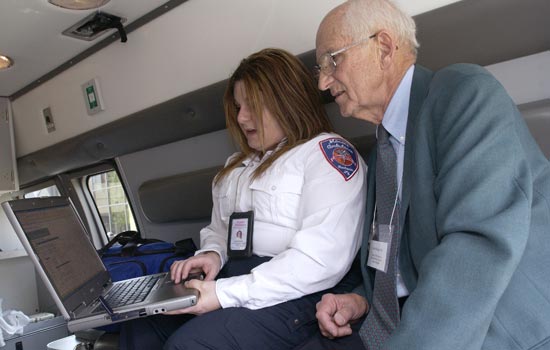Students create online life-saving resource
A. Sue Weisler | photographer
Mindi Meath, left, Monroe Ambulance director of training, shows David Kluge, founder of STEP, how Monroe EMTs and paramedics can access the online directory while en route to the hospital.
Every second matters when firefighters, emergency medical personnel, and police officers are called to the scene of an emergency. In an effort to ensure they have the most comprehensive, up-to-date information for area hospitals, doctors and ambulance bases, RIT has developed the Emergency Medical Services Online Directory. STEP (Society for Total Emergency Programs) Council of the Genesee Region, which produces an annual reference book, sought the technical expertise of RIT’s software engineering students in developing the online database.
RIT’s Center for Advancing the Study of Cyberinfrastructure hosts the directory and will spearhead future development and research initiatives. Nearly 50 people from various counties throughout New York state attended the “From Home to Hospital” conference May 9 at RIT. The goal of the conference was to encourage other counties to utilize the online directory as well as examine ways to improve emergency access information. The EMS Online Directory, is currently utilized by emergency medical services in Monroe and Livingston counties. The information is also available to the public.
Monroe Ambulance’s EMTs and paramedics can access the directory from the field using wireless technology. “Oftentimes, patients may not know the hospital affiliation of their physician,” says Mindi Meath, director of training of Monroe Ambulance. “The online directory enables field EMS providers to save time during non-life-threatening situations and accurately transport patients to the facility their personal physician is affiliated with.” In addition to EMS providers, the directory is also a lifesaving resource for the public.
The directory includes valuable contact information for numerous ancillary organizations at the local, state and national levels, such as the American Red Cross, Alternatives for Battered Women, Lifespan and the Centers for Disease Control. “We hope to expand the Directory to include all 62 counties in New York state,” says David Kluge, STEP founder and editor of the STEP EMS Directory. “It provides the necessary interface between the first responders, physicians and the emergency departments of all area hospitals. From the moment first responders arrive at the scene to the point at which doctors begin caring for the patient in the emergency room, the process should be as seamless as possible. All the information is just a click away.” Guy Johnson, director of RIT’s Center for Advancing the Study of Cyberinfrastructure says: “We want to continue to improve the site’s capabilities including efforts in data mining or the merging of information without having to manually input the data. We will correlate the information in a way that improves emergency medical services.” RIT software engineering students for the past several years worked on the directory for their senior projects.
They designed the software so any U.S. county can input its data. “My team provided daily support, both fixing any technical problems and helping organizations use the directory,” says Dave Beaton, a 2006 RIT graduate who currently works at Paychex Inc. “This project provided a very unique opportunity for us because it allowed us to implement a real world application which people utilize on a daily basis.”









